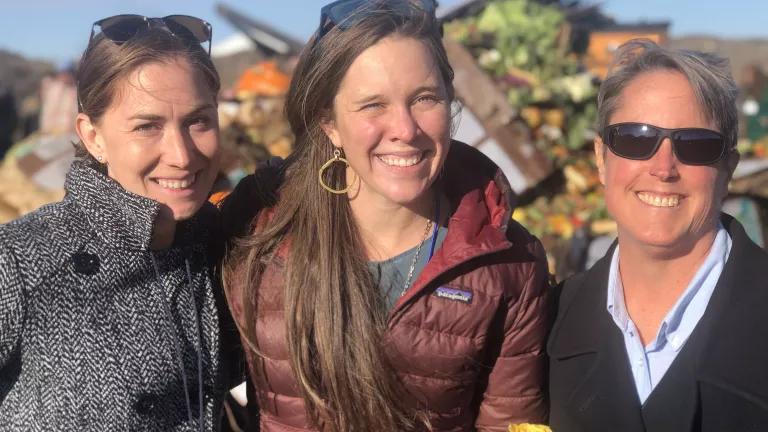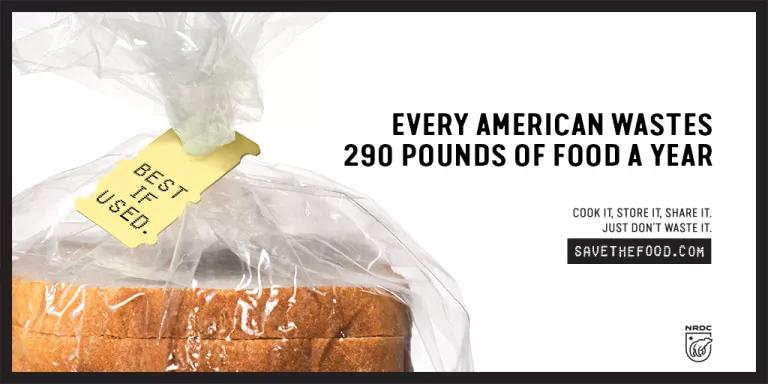Food Systems Analyst
Andrea Spacht Collins is working to minimize food waste by changing the way we think about what we eat—and what we don’t eat, where it comes from, and where it ends up.

Andrea Spacht Collins (left) with fellow NRDC colleagues Maddie Keating (center) and Darby Hoover (right)
As a food policy expert in NRDC’s Healthy People & Thriving Communities Program, Andrea Spacht Collins focuses on making our food systems more efficient, sustainable, and equitable, from farm to table and all points in between. Her team authored the seminal 2012 report Wasted, which helped spread awareness that up to 40 percent of food in the United States goes uneaten, and the follow-up edition in 2017 outlining policy ideas to overcome this problem. Alongside their ongoing work to highlight the climate implications of food waste—which creates the potent greenhouse gas methane as it decays—Collins and her colleagues are building systemic solutions in cities across the nation.
Food waste is most often talked about as a climate problem, but you’ve pointed out that it is also a social justice issue. How are they connected?
Food waste accounts for nearly 22 percent of what we toss in our landfills. The greenhouse gases emitted by all this rotting food each year are equivalent to the emissions from three million cars. In addition, we’re wasting all of the resources that go into producing that food: water, land, chemicals, and energy. Taken together, the processes for growing, cooling, and transporting all of our wasted food add up to the equivalent of emissions from another 34 million cars. That’s why it is important for us to prevent food from becoming waste and to ensure that only inedible food scraps go into our compost piles.
There are many structural problems that contribute to all this waste, and this includes our unjust food system. Racism has always been an undercurrent in food production in the United States, from an agricultural system built on slavery to modern-day worker exploitation by multinational corporations seeking to profit from industrial farming practices and meet consumer demand for cheap, fast, readily available food. Food waste, specifically, can be an environmental justice issue in that the siting of solid waste infrastructure, such as incinerators, landfills, and processing facilities, exposes people living nearby to harmful air pollution. But the flip side is that local food waste solutions can also confer real benefits that help eliminate pollution, often by encouraging the development of community-level composting—which recycles nutrients back into the soil—as well as urban gardening and green jobs programs.
What is NRDC doing to help promote these solutions on the ground?
We’ve identified local governments as key drivers in reducing food waste. Cities across the country are motivated and well positioned to limit the amount of wasted food; NRDC’s Food Matters project has partnered with many of these cities to implement comprehensive policies and programs. In Baltimore, where the Wheelabrator, or BRESCO, incinerator is the city’s single-largest polluter, we’re helping to support a community-run food scrap pickup and composting service that employs local teens and helping city officials advance their goal to cut commercial food waste by 80 percent by 2040. In Denver, we’re partnering with the Department of Public Health & Environment and providing grants to small businesses and nonprofits working to reduce food waste, including one that redistributes excess food from businesses to food banks and homeless shelters. And in Nashville, we’re engaging governments, restaurants, community institutions, and retailers to rescue surplus food to direct to people in need and to compost what’s left to help build healthy soil. We’re working to replicate these successes through a network in which best practices can be shared and further developed, so that other cities don’t have to reinvent the wheel.

What can we, as consumers, do to contribute to reducing food waste?
It’s estimated that 43 percent of food waste in the United States takes place inside our homes. For many consumers, the cost of food is relatively low compared with other household costs, so some people simply don’t see the time that it takes to efficiently manage their food as time well spent. Busy schedules don’t allow for creative approaches to using up food scraps at home.
NRDC designed its Save the Food website to help folks identify and change the small behaviors that lead to food waste at home. It has an extensive guide to help people store their food so that it lasts longer, interactive tools to help with portions and planning, and recipes to help with using up food scraps or reimagining leftovers. Consumers should also be telling their favorite food businesses that they care about food waste, asking them to prevent food from becoming waste in the first place and to donate any surplus.
Where else in the food supply chain is waste most likely to occur?
It takes place at every level. Some food gets left on farms because farmers don’t have a market to pay for the costs of growing and picking it. At the manufacturing level, processors often create edible by-products that never make it to shelves. Banquet halls overproduce food so they can be sure they won’t run out; restaurants stock supplies for extensive menus and enormous plate sizes.
Why is so much food still going to waste right now, during the coronavirus pandemic, when so many people are struggling economically and experiencing food insecurity as a result?
Our food systems have become very complex, and changes in one part of the system have a ripple effect along the entire supply. With many businesses closed to help reduce the spread of COVID-19, our food purchasing practices have changed dramatically. But food growers and producers aren’t able to adjust so quickly in response; the food that’s on our plates now was planned for and planted many months ago. And now, with so much uncertainty about what things will be like in the coming months, it’s even more difficult for food producers to plan ahead. Unpredictability in food purchasing leads to waste.
What role does the federal government play in all of this?
Food plays such a central part in our lives that it falls within the purview of several different agencies. The USDA is responsible for domestic food production. The FDA is responsible for food safety, including the safety of imported foods. The NIH is concerned about our health and nutrition. And the EPA is responsible for waste management, even if most waste management is actually undertaken at the municipal and regional levels. The lack of a central hub for deciding food policy has made it difficult to assess real-time data on how much food is being wasted, where it’s being wasted, and why. As a result, the government has mostly left food businesses to deal with the solutions.
Are there any legislative proposals to centralize some of that decision making?
One key place where federal regulation could help reduce food waste is in standardizing the date labels on our food. With the exception of labels on infant formula, these misnamed “expiration” dates aren’t federally regulated. Instead we have to deal with a patchwork of state laws that leads to consumer confusion. Studies have shown that 80 percent of us toss food prematurely because of the way we misinterpret these dates. We need to pass legislation like the bipartisan Food Date Labeling Act to end consumer confusion and keep perfectly good food out of the trash.
This NRDC.org story is available for online republication by news media outlets or nonprofits under these conditions: The writer(s) must be credited with a byline; you must note prominently that the story was originally published by NRDC.org and link to the original; the story cannot be edited (beyond simple things such as grammar); you can’t resell the story in any form or grant republishing rights to other outlets; you can’t republish our material wholesale or automatically—you need to select stories individually; you can’t republish the photos or graphics on our site without specific permission; you should drop us a note to let us know when you’ve used one of our stories.


Baltimore Is Poised to Put a Major Dent in Its Food Waste Stream
This Thanksgiving, Nashville Saves Food and Feeds the Hungry
Taking Care of the Food Workers Who Take Care of Us